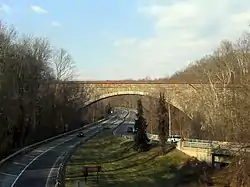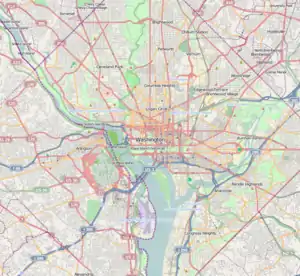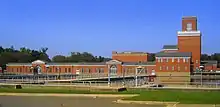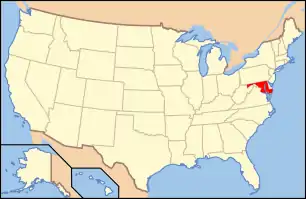Washington Aqueduct
The Washington Aqueduct is an aqueduct that provides the public water supply system serving Washington, D.C., and parts of its suburbs. One of the first major aqueduct projects in the United States, the Aqueduct was commissioned by Congress in 1852, and construction began in 1853 under the supervision of Montgomery C. Meigs and the US Army Corps of Engineers (which still owns and operates the system out of Baltimore District of the Corps). Portions of the Aqueduct went online on January 3, 1859, and the full pipeline began operating in 1864.[1] The system has been in continuous use ever since. It is listed as a National Historic Landmark, and the Union Arch Bridge within the system is listed as a Historic Civil Engineering Landmark.
Washington Aqueduct | |
 The Union Arch Bridge carries the Washington Aqueduct across Cabin John Creek. | |
 Dalecarlia Reservoir & Treatment Plant | |
| Location | 5900 MacArthur Blvd., NW Washington, D.C. |
|---|---|
| Coordinates | 38°56′15″N 77°6′51″W |
| Built | 1853-1864 |
| Architect | Montgomery C. Meigs |
| NRHP reference No. | 73002123 |
| Significant dates | |
| Added to NRHP | September 8, 1973 |
| Designated NHL | November 7, 1973 |
Design and facilities
The centerpiece of the Aqueduct is a 12-mile (19 km) pipeline which connects the system's dam at Great Falls with the Dalecarlia Reservoir on the border with Montgomery County, Maryland. The pipeline runs along what is now MacArthur Boulevard, traversing some of the higher cliffs along the Potomac River.

The Union Arch Bridge carries the pipeline and MacArthur Boulevard over Cabin John Creek and the Cabin John Parkway near the community of Cabin John, Maryland. This bridge was the longest masonry arch bridge in the world for 40 years after its completion.[2][3]
The Dalecarlia Reservoir serves as a primary sedimentation basin. A portion of the water from the reservoir is treated at the nearby Dalecarlia Water Treatment Plant and distributed to municipal water mains. The remainder of the water from the reservoir flows to the Georgetown Reservoir in Georgetown. This facility serves as an additional sedimentation basin, and then the water flows through the Washington City Tunnel to the treatment facility at the McMillan Reservoir, after which it is pumped through city mains.
System expansion

The system originally used a single pipe for water delivery, and did not have any water purification plants, relying instead on the reservoirs to act as settling basins. By the turn of the 20th century, however, Washington's growth and the high amount of sediment in the Potomac's water kept the reservoirs from doing their jobs well, and so the first treatment plant, a massive slow sand filter bed system, was installed at McMillan Reservoir, and was completed in 1905.[4]:Ch.4 The regular use of chlorine as a disinfectant began in 1923 at the McMillan plant. The McMillan plant was not replaced until 1985, when a rapid sand filter plant was opened adjacent to it.[1] Efforts are under way to redevelop the land the slow sand plant used, while maintaining some of the plant's sand silos for historical purposes.
In the 1920s, the Aqueduct was upgraded with the addition of a second pipe from Great Falls to Dalecarlia, along with several new reservoirs and a pumping station, A rapid sand filter plant was built at Dalecarlia Reservoir, which went online in 1927.[4]:204–205 The Dalecarlia plant is the larger of the two plants in the system, having been upgraded in the 1950s, and is the plant that serves the Virginia communities that use the Aqueduct. The Corps built an additional intake and pumping station at Little Falls in 1959.[4]:256
Operations and service area
The Aqueduct is a wholesale water supplier. The communities it serves are responsible for billing customers and managing water mains. The service area is:
- Washington, D.C., and most of the federal installations in the city (via DC Water)
- Arlington County, Virginia
- The city of Falls Church, Virginia, and part of Fairfax County (particularly McLean).
References
| Wikimedia Commons has media related to Washington Aqueduct. |
- Ways, Harry C. (1996). The Washington Aqueduct: 1852-1992. Baltimore, MD: U.S. Army Corps of Engineers, Baltimore District.
- Norman Metzger (March 2004). "A Sycamore Neighbor: The Washington Aqueduct". Sycamore Islander.
- National Park Service (July 19, 2006). "The Washington Aqueduct System".
- Scott, Pamela (2007). Capital Engineers: The U.S. Army Corps of Engineers in the Development of Washington, D.C., 1790-2004. Washington, D.C.: U.S. Army Corps of Engineers. ISBN 978-0160795572. Archived from the original on 2009-07-22. Retrieved 2014-09-02. Publication No. EP 870-1-67.
- "The Corps Has Helped Solve Urban Water Problems Since 1824 - Beginning at the White House". Headquarters; History. Washington, D.C.: U.S. Army Corps of Engineers. October 2002. Historical Vignette 059. Archived from the original on 2011-06-04.
Further reading
- Chick, H.M. (1934). History and construction of the aqueduct leading to McMillan Park, Washington, D.C. (Thesis). College Park, MD: University of Maryland. ARCV 72-115.41. Records of Phi Mu, Special Collections, University of Maryland Libraries.
External links
| Wikimedia Commons has media related to Washington Aqueduct. |
- U.S. Army Corps of Engineers: official Washington Aqueduct website
- National Park Service.gov: A longer history of the system, from the C&O Canal site
- National Park Service.gov: National Historic Landmarks Program & the Washington Aqueduct
- Maps of the Washington Aqueduct, Md. and Washington D.C. : to accompany supplemental report of Chief Engineer dated Feb. 22nd 1864
- Washington Aqueduct, Montgomery County, Inventory No.: M: 29-49 at Maryland Historical Trust website

